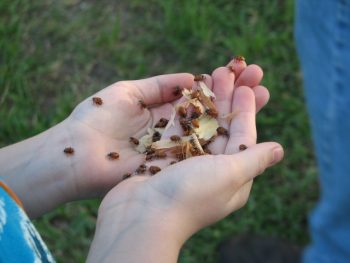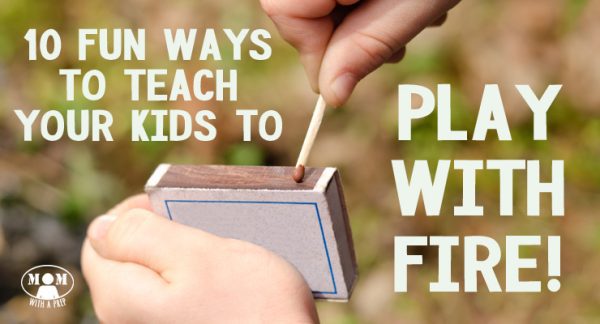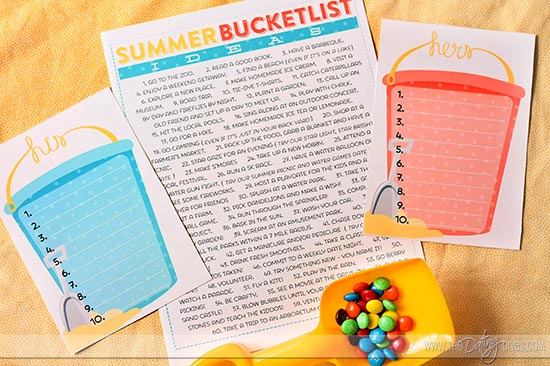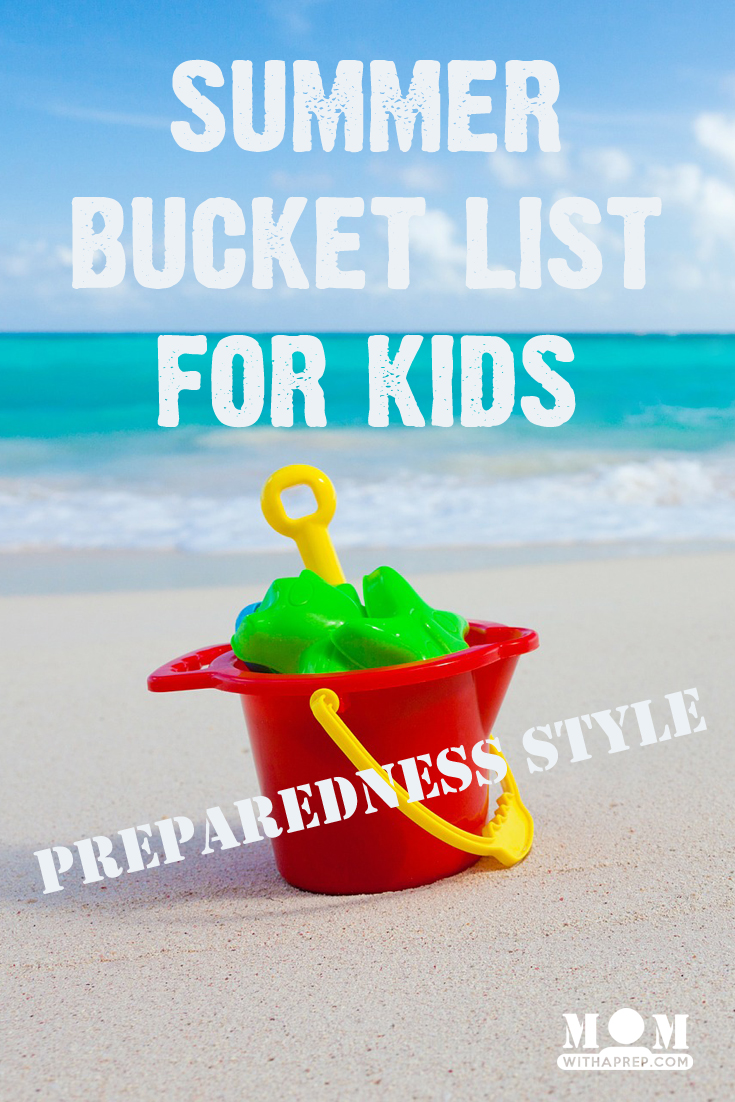Take your summer bucket list for kids up a notch – preparedness style! Learn to use everyday summer activities and develop a preparedness mindset for kids!
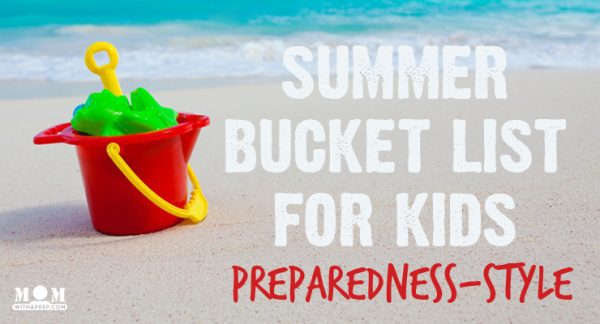
There’s 104 days of summer vacation …. and what are you going to do to fill your kids’ buckets full of memories this summer?
There is always so much pressure to make every single moment count with huge activities and stuff to do. And while having fun things to do during the summer are great, sometimes those down times are really important, too!
But what if you could enrich your child’s summer with things to do that also prepare them for emergencies – big and small? Among the trips to the zoo, video game themed play days, make time to do activities that further their survival skills, their community awareness, their self reliant skills and more! You can sprinkle these activities among the ones you’ve already planned for the summer, or do a themed preparedness summer camp with neighborhood kids or families who are like minded (maybe even sneak some in for those who aren’t!)
Don’t Panic!
With each of these ideas, don’t assume something simple means just go do the same old activity every other list suggests. There are ideas you may not have thought of in the particular light of preparedness that you can add!
Our goal isn’t to scare our kids into the fear of something bad happening, but to empower them to be able to handle the bad things that do happen.
They’ll have knowledge, muscle memory, a plan, and a way to cope that will live with them well into their adult lives!
Don’t feel daunted by this bucket list. This isn’t a list you have to accomplish. This is a list to pick and choose from and then move on! We want to practice, learn, encourage and grow, not feel stressed that there’s yet another list that we have to accomplish to be the perfect parents raising the perfect kids.
Summer Bucket List for Kids – Preparedness Style
1. HAVE A “LIGHTS OUT” DAY
Since you won’t have to really worry about getting ready for school the next day, spend one day with an emergency power drill. Shut off the power, and have the kids learn how to cope without. Then evaluate the day – were you prepared with enough ready food, water, etc.? How did you keep yourself cool? Then create a Lights-Out kit based off of what you learned!
2. GO CAMPING
This doesn’t mean you have to make a huge production out of it. Go camping in the living room, or your backyard! Let the kids pack camping bags to have with them outside, learn about powerless cooking and lighting, and maybe even potty breaks without a bathroom!
3. GO FISHING
There are tons of reasons to go fishing, more than just kicking back, though that’s always good, too! Learn to make a floating compass – water play plus science plus survival skills. How fun is this!? Whether you try it at the local pond, the lake or the ocean, or even the creek, fishing is a great way to teach survival skills, learn about self sufficiency, and more!
4. WATCH A MOVIE
It’s a rainy summer afternoon, and everyone is bored. Why not watch a movie? Not just any movie, but a movie geared towards kids being caught in survival situations and how they coped. From Homeward Bound to Hunger Games, movies run the gamut of survival stories for kids of all ages. (You can also get a list of books in the same genre here) Pop some popcorn, and spend a rainy summer’s day (or one that’s just too hot to be outside) enjoying some high adventure and learning a few things!
• READ MORE: MAKE YOUR OWN POPCORN SALT
5. PLAY ZOO TYCOON – LITERALLY
Build an earthworm bin. Make a bird house (we use pallet wood and go for it!). Raise some rabbits, get some chickens. Build bird feeders. Plant a butterfly garden. Release some lady bugs. There are ways to encourage nature to help us in our garden, learn some easy homesteading skills, and even the life cycle of where our food comes from.
6. PICK YOUR OWN
Take a day trip to a pick your own farm (this might be a good trip to plan for!) and fill a bucket with fruits and/or vegetables to bring home and preserve. Either can, freeze or dehydrate to help replenish your family’s food storage.
• READ MORE: USE A PICK YOUR OWN FARM TO BUILD YOUR FOOD STORAGE
7. PLAN A TRIP … THEN TAKE IT!
Get out maps, pens, paper and some big wishes, and plan a trip to someplace that may just be an hour away. Help the kids learn how to read a map, plan a couple of alternative routes, manage the budget, plan meals, etc. Then TAKE IT! Test their plan, let them learn from mistakes and feel proud of what they did.
8. PLAY DOCTOR
Well, maybe just take a First Aid/CPR class. Many cities offer affordable CPR classes at local activity centers. But you can also check with your fire station, local emergency groups, etc., for classes that may be free to the public. And if you’ve got kids that are too small, teach them basic first aid with their dolls and action figures. Get out the bandaids, cut up some triangles of cloth to make bandages and splints. Learn how to care for boo-boos. Make a game out of learning to all 911.
9. GO SWIMMING
If your kids can’t swim, this is the perfect time to enroll them in classes to learn, or teach them yourself. It’s a summertime survival skill all kids need.
REMEMBER: Drowning doesn’t look like drowning – be prepared to know the signs.
10. RIDE A BIKE
Not only are you getting exercise, your kids are learning how to navigate their surroundings. Even the most basic ideas of an emergency kit (having a tire kit, water and a small first aid kit handy) can be reinforced with a day out on bikes. Make sure to have a great helmet – it’s also doubles as head protection during severe weather!
• READ MORE – Reasons to teach your kids to ride a bike!
11. START A BOOK CLUB
Go to the library often. Check out books that are silly, that feed adventure to the mind, but also check out books on plant and tree identification, on survival skills, on biographies of people who have survived disasters, on homesteading skills.
• READ MORE: 20+ Great Survival Books for Kids
12. LEARN HOW TO WHITTLE
What?! Teach your kids knife skills? Yes. Whittling is a great way to learn some basic knife skills, pass by time waiting for the fireflies to begin lighting up, and developing a preparedness skill useful in so many ways.
13. PLAY HIDE AND SEEK
Typical outdoor children’s games can be full of fun, as well as ways to teach important preparedness skills.
14. BUILD A FIRE PIT
Sure, local no-burn ordinances will have to be watched, but building a fire pit gives you a ton of skill-building opportunities. Our basic fire pit took little manual labor, some great bonding time, and allows us to learn to start fires, cook off grid, enjoy evenings around the campfire telling stories, making s’mores, and more!
15. PLANT A GARDEN
Do a small herb garden in a bucket (we like these for small spaces). If you have no place to put plants, volunteer some time in a community garden close to you to help kids learn where their food comes from. Herbs are easy to plant, easy to maintain. Other easy plants would be radishes, green onions or even green beans.
16. PLAY IN THE WATER!
Fill a bucket full of water, and have the kids learn how to wash clothes, fill up water bottles for storage (be sure to have safe storage procedures in place – clean hands, clean containers and clean water!), play silly games with these awesome water toys (or even make your own), run in a sprinkler (see this list of PVC projects for a great ‘car wash’ for kids), wash cars, water the garden. Lots of water play time can be done outdoors that can add value to homesteading/preparedness skills for kids.
17. BUILD A FORT
Or better yet, build shelter! Use the rainy days to build shelters inside (chair fort anyone?), and great days to learn how to build lean-to’s and put up tents in the backyard.
18. TAKE A HIKE
And along the way, identify edible plants in your area (remember those books from the library you check out?). Learn how to mark trails for hiking, learn to identify trees and animal life, learn how to blend in and when to make yourself known. Grab your emergency bag and practice carrying it and uses the tools inside. Taking a hike is a great way to build fitness, see the sites, and spend a great day outdoors. But what about taking it a step further and throwing on your 72 hour emergency bag (don’t have one? Click here for a great printable list to get started!), and spending the day practicing using what’s in your kit. Use your water filter, eat your snacks, use the maps, etc.
FREE CHECKLIST: CREATE A 72 HOUR EMERGENCY KIT
19. GO STARGAZING
Find some dark sky and put out some blankets and watch the skies! It’s a great time to teach navigation skills by the stars, plus some great downtime to just enjoy nature at its quietest (or maybe not so much if you’re near a braying donkey who doesn’t like your proximity to his sheep, or the cicadas, or the coyotes … ) These DIY flashlight constellation cards can be loads of fun and reinforce what they’ve learned at home in their rooms.
20. PLAY GAMES – AT NIGHT!
Collect glow sticks from your local dollar store, box store or even Amazon, and stock your emergency bags and kits with. Use a few extras to play a game of capture the flag (see rules here) or break open to fill soda bottles full of water to have a glow in the dark bowling game. There are other great games you can play with no power here. You’re learning to use an item from your emergency kit, creating community, and getting in shape! Alternatively, play a game of flashlight tag (same idea, use something from your emergency kit – but remember to restock it or replenish the charge/batteries when done!)
21. PLAY IN THE KITCHEN
Not only is it great for school skills (math, reasoning, order, chemistry), learning how to cook gives kids really valuable self-reliance skills. Try this homemade hummus for a great snack anytime! Work with food storage and teach your kids how to cook with AND without power! It’s also a great way to introduce food preservation and food safety. And for your older kids, begin teaching menu planning and budgeting and let them plan, shop and prepare the foods themselves.
22. VOLUNTEER
Nothing is better than helping develop a sense of community in our children. And by community, I don’t mean friendships. But thinking outside our smaller circles of family and friends to the greater community, learning to give back, to do more, to help out in times of need. Volunteer at a food bank, at a nursing home, help a neighbor mow the lawn who is in need,
• READ MORE: BE A COMMUNITY HELPER IN A TIME OF DISASTER
23. GET A JOB
Summer is a great time for kids to begin to learn the idea of self reliance through work projects. Maybe they can build a lemonade stand or dog sit, or do chores for a local farmer, or babysit, or even get a small part time job. Then it’s a great time to stretch the lesson to money management and charity!
24. GO FOR A DRIVE
Teach your kids to pay attention to details, learn their whereabouts, look for landmarks and clues. Give them a map of where you’ll be driving and have them figure out where they are. Then turn around and have them tell you how to get home based on their maps and their observation skills. Be sure to make sure your car’s emergency kit is fully stocked! Use this printable to let them check off the list before you head out!
25. TIE YOURSELF UP IN KNOTS
Grab a knot tying book, and spend the summer learning new knot skills. You can graduate to paracord projects, macrame for decorating and even things like survival skills and netting!
26. SUMMER OLYMPICS IN THE BACKYARD
Set up an obstacle course, a shooting range (nerf, water guns, bows, slingshots), a water park, and other crazy physical things to give your children a place to play. Better yet, let THEM do it! Not only are you giving them a chance to be physical, you’re giving them problem-solving opportunities and chances to practice good sportsmanship and team development.
27. TAKE OUT THE TRASH
Kids are ingenious when you put a bunch of ‘stuff’ in front of them and say go to it!
- Too many pizza boxes? Let your kids find ways to come up with creative solutions to a problem you have a as a family.
- How can you reuse all those cardboard egg cartons? (Hint: Make fire starters with old crayons that have been melted and dryer lint).
- Have a bunch of soda bottles you keep meaning to fill with water? Learn how to make them into water filters.
- Empty pill bottles? Learn how to make a variety of survival kits of all kinds.
28. GO GEO-CACHING
This really is a fun family activity. It ties in to navigating, hiking, exploring, games, treasure hunting and more. It’s free to do if you have the geocaching app on your phone – Android and iPhone ( here’s how to without a smartphone ). Just remember some etiquette: don’t go on private property, replace the treasure if you take the treasure, be aware of your surroundings at all times.
29. BE A DRILL SARGENT!
STOP THE CAR! Everyone jump out, run around, and jump back in! These were always fun drills to do with our friends when we were young. So why not do it at home, with skills you’ve been learning all year?
- Fire Drill (indoors and out)
- Emergency Evacuation Drill
- First Aid Drill
- Tornado Drill
- Earthquake
Use a morning when everyone is dragging from yesterday’s swim date to generate some excitement and get crazy.
30. MAKE YOUR OWN BOARD GAMES
There are free printable board game blanks all over the internet (file folder games are great for this because they store so easily). Have your kids create fun board games with painted acorn tops or other found objects as the place markers. Create a card game of plant identification, or a trivia game on survival and preparedness skills. Get out the art supplies and let them have a go! Wildcraft is a great game that you can keep in your game cupboard, too!
Tip: Use soap storage bins from the dollar store to store card games in.
31. TAKE A FIELD TRIP
Make it a field trip that counts! Visit a ham radio club to learn about communication, gather a group and take a tour of a fire station and learn about fire safety. Find a crafts-person who makes soap, sews, does blacksmithing, has a chicken coop, who does wildcrafting, or other homesteading skills. Visit an elderly person and talk to them about what growing up was like. You might be able to find trades people who would love to show off their skills! Visit farmer’s markets where you can get great information.
32. LEARN A SKILL
YouTube is your friend. Pick a craft or trade to learn, and watch YouTube videos or talk to people who do it for a living/hobby. Crocheting and knitting are easy to pick up with how-to books from the library or videos on YouTube. Cooking is one you can teach 🙂 Canning is a easy when you start with jam. Simple car repair and maintenance is great for everyone to learn. Pick two or three you and your kids would like to learn this summer and dive in!
• READ MORE: 150 HOMESTEADING AND SURVIVAL SKILLS TO KNOW
32. START A CO-OP or SUMMER CAMP
Instead of just doing things yourself, have a weekly co-op where you participate in doing any one of these activities with friends. It makes everything even more fun!
Do you have fun activities that you do with your kids that translate well into preparedness activities? Please share them and we’ll add them to the list!
PRINT YOUR OWN BUCKET LIST!
Use some of the ideas you’ve gotten here, or even other places on the web, and let your kids create those lists that are interesting to them! Print off these adorable bucket lists to fill out, then go have an awesome summer! This printable can be found DatingDivas.com
Katy Willis is a writer, lifelong homesteader, and master herbalist, master gardener, and canine nutritionist. Katy is a preparedness expert and modern homesteader practicing everyday preparedness, sustainability, and a holistic lifestyle.
She knows how important it is to be prepared for whatever life throws at you, because you just never know what's coming. And preparedness helps you give your family the best chance to thrive in any situation.
Katy is passionate about living naturally, growing food, keeping livestock, foraging, and making and using herbal remedies. Katy is an experienced herbalist and a member of the CMA (Complementary Medical Association).
Her preparedness skills go beyond just being "ready", she's ready to survive the initial disaster, and thrive afterward, too. She grows 100% organic food on roughly 15 acres and raises goats, chickens, and ducks. She also lovingly tends her orchard, where she grows many different fruit trees. And, because she likes to know exactly what she's feeding her family, she's a seasoned from-scratch cook and gluten-free baker.
Katy teaches foraging and environmental education classes, too, including self-sufficient living, modern homesteading, seed saving, and organic vegetable gardening.
Katy helps others learn forgotten skills, including basic survival skills and self-reliance.
She's been published on sites such as MSN, Angi, Home Advisor, Family Handyman, Wealth of Geeks, Readers Digest, and more.

